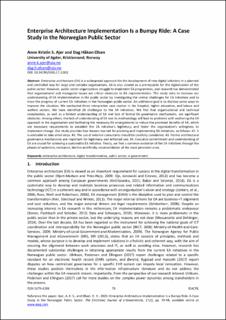Enterprise Architecture Implementation Is a Bumpy Ride: A Case Study in the Norwegian Public Sector
Peer reviewed, Journal article
Published version
Permanent lenke
https://hdl.handle.net/11250/3100835Utgivelsesdato
2019Metadata
Vis full innførselSamlinger
Originalversjon
Ajer, A. K. S. & Olsen, D. H. (2020). Enterprise Architecture Implementation Is a Bumpy Ride: A Case Study in the Norwegian Public Sector. Electronic Journal of e-Government, 17 (2), 79-94. https://doi.org/10.34190/EJEG.17.2.002Sammendrag
Enterprise architecture (EA) is a widespread approach for the development of new digital solutions in a planned and controlled way for large and complex organisations. EA is also viewed as a prerequisite for the digitalisation of the public sector. However, public sector organisations struggle to implement EA programmes, and research has demonstrated that organisational and managerial issues are critical obstacles to EA implementation. This study aims to increase our understanding of EA implementation in the public sector by investigating the central challenges for EA initiatives and to trace the progress of current EA initiatives in the Norwegian public sector. An additional goal is to disclose some ways to improve the situation. We conducted three interpretive case studies in the hospital, higher education, and labour and welfare sectors. We have identified 28 challenges to the EA initiatives. We find that organisational and technical complexities, as well as a limited understanding of EA and lack of formal EA governance mechanisms, are significant obstacles. Among others, the lack of understanding of EA and its methodology will lead to problems with anchoring the EA approach in the organisation and facilitating the necessary EA arrangements to induce the promised benefits of EA, which are necessary requirements to establish the EA initiative’s legitimacy and foster the organisation’s willingness to implement change. Our study provides four lessons learned for planning and implementing EA initiatives, as follows: #1. It is advisable to take small steps. #2. The use of external consultants should be carefully considered. #3. Formal architectural governance mechanisms are important for legitimacy and enforced use. #4. Executive commitment and understanding of EA are crucial for achieving a sustainable EA initiative. Finally, we find a common evolution of the EA initiatives through the phases of optimism, resistance, decline and finally, reconsolidation of the most persistent ones.

